-
 Bitcoin
Bitcoin $107,295.8208
-0.70% -
 Ethereum
Ethereum $2,492.0775
0.43% -
 Tether USDt
Tether USDt $1.0003
0.01% -
 XRP
XRP $2.2672
2.59% -
 BNB
BNB $657.3063
0.71% -
 Solana
Solana $155.4040
0.64% -
 USDC
USDC $1.0001
0.03% -
 TRON
TRON $0.2798
1.48% -
 Dogecoin
Dogecoin $0.1657
-2.25% -
 Cardano
Cardano $0.5757
-0.98% -
 Hyperliquid
Hyperliquid $40.1401
2.38% -
 Bitcoin Cash
Bitcoin Cash $505.7437
0.22% -
 Sui
Sui $2.7808
-3.95% -
 Chainlink
Chainlink $13.4275
-1.93% -
 UNUS SED LEO
UNUS SED LEO $9.0389
-0.23% -
 Avalanche
Avalanche $17.9698
-4.20% -
 Stellar
Stellar $0.2390
-0.94% -
 Toncoin
Toncoin $2.9224
0.36% -
 Shiba Inu
Shiba Inu $0.0...01144
-4.23% -
 Litecoin
Litecoin $86.8633
-1.49% -
 Hedera
Hedera $0.1507
-1.64% -
 Monero
Monero $321.0263
2.89% -
 Polkadot
Polkadot $3.4103
-3.78% -
 Dai
Dai $1.0000
0.02% -
 Bitget Token
Bitget Token $4.5517
-1.30% -
 Ethena USDe
Ethena USDe $1.0003
0.01% -
 Uniswap
Uniswap $7.1448
-4.37% -
 Aave
Aave $273.9902
-1.95% -
 Pepe
Pepe $0.0...09786
-5.75% -
 Pi
Pi $0.5090
-5.09%
How to interpret the RSI bottom divergence when the moving average is arranged in a short position?
RSI bottom divergence suggests weakening downtrend momentum, especially when paired with bearish moving averages, offering potential reversal signals in volatile crypto markets.
Jun 30, 2025 at 11:15 pm
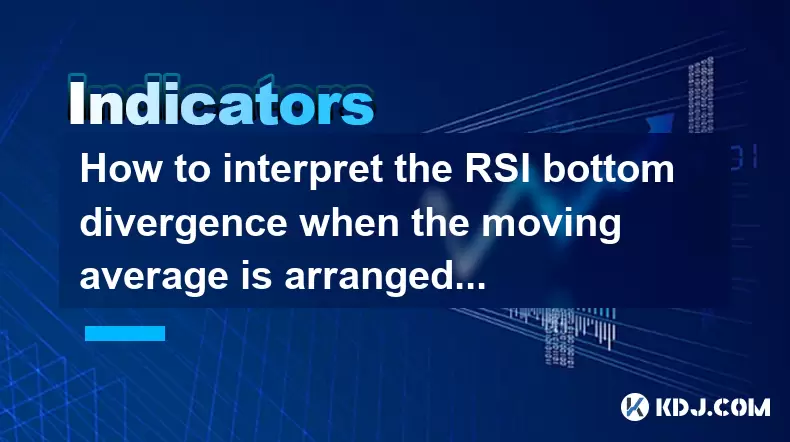
Understanding RSI and Moving Averages in Technical Analysis
The Relative Strength Index (RSI) is a momentum oscillator that measures the speed and change of price movements. It typically ranges from 0 to 100 and is used to identify overbought or oversold conditions in a market. When the RSI drops below 30, it's often considered oversold, and when it rises above 70, it's seen as overbought. However, these levels can vary depending on market conditions and trader preferences.
Moving averages, such as the Simple Moving Average (SMA) and Exponential Moving Average (EMA), are trend-following indicators that smooth out price data to help traders identify the direction of the trend. In a bearish setup, short-term moving averages like the 5-period EMA may fall below longer-term ones like the 20-period EMA, indicating a potential downtrend.
When analyzing RSI bottom divergence alongside a short-positioned moving average arrangement, traders look for signs that the current downtrend may be losing strength, even though the moving averages suggest continued bearish momentum.
What Is RSI Bottom Divergence?
An RSI bottom divergence occurs when the price makes a new low, but the RSI does not confirm this move by making a corresponding new low. Instead, the RSI forms a higher low, suggesting that the downward momentum is weakening. This divergence can signal a potential reversal from a downtrend to an uptrend or at least a corrective bounce.
For example:
- Price reaches a new low at $30,000.
- The RSI also reaches a low, say 25.
- Later, price drops again to $29,000, a new low.
- But the RSI only drops to 30, forming a higher low.
This indicates that although the price continues to fall, the selling pressure is decreasing, which may precede a bullish reversal.
In the context of cryptocurrency markets, where volatility is high and trends can reverse quickly, recognizing this pattern becomes crucial for timing entries or exits during downtrends.
Interpreting Short-Positioned Moving Averages
A short-positioned moving average arrangement refers to a situation where shorter-term moving averages are positioned below longer-term ones. For instance:
- The 50-day MA is below the 200-day MA, commonly known as a "death cross."
- Or in intraday charts, the 9 EMA is below the 21 EMA, signaling short-term bearishness.
This configuration suggests that the overall trend is bearish, and traders might be advised to avoid long positions unless there's strong evidence of a reversal.
However, when this bearish setup coincides with a bullish RSI divergence, it creates a conflict between momentum and trend indicators. Traders must assess whether the divergence is strong enough to override the bearish alignment of moving averages or if it’s just a temporary retracement within a larger downtrend.
Combining RSI Bottom Divergence with Short-Term Moving Average Alignment
When both RSI bottom divergence and a bearish moving average structure occur simultaneously, traders face a nuanced decision-making process. Here’s how to interpret the combination:
- Price is in a downtrend, confirmed by moving averages being aligned in descending order.
- Momentum begins to shift, as evidenced by RSI forming higher lows while price makes lower lows.
- This contradiction implies that sellers are losing control, and buyers might be stepping in cautiously.
Traders should pay attention to volume during this phase. An increase in buying volume during the formation of the RSI divergence could strengthen the case for a reversal. Conversely, if volume remains low or spikes on the downside, the divergence may not hold.
Additionally, using candlestick patterns like hammer candles or morning stars near key support levels can add confirmation to the RSI divergence signal.
Practical Steps to Trade RSI Bottom Divergence in a Bearish Setup
Trading this scenario requires careful planning and risk management. Here’s a step-by-step approach:
- Identify a clear downtrend using moving averages (e.g., 9 EMA < 21 EMA).
- Look for price making a series of lower lows.
- Observe RSI making higher lows during the same period — this confirms the divergence.
- Wait for a price reaction, such as a bullish candlestick pattern or a close above a recent swing high.
- Enter a long position once confirmation is observed, placing a stop-loss below the most recent swing low.
- Set a take-profit level based on previous resistance zones or Fibonacci extensions.
It's essential to use multiple timeframes. For instance, a daily chart might show bearish moving averages, but the 4-hour or 1-hour chart may reveal a stronger RSI divergence and clearer entry point.
Also, consider using volume indicators like OBV (On-Balance Volume) or Chaikin Money Flow to validate buying pressure.
Frequently Asked Questions
Q: Can RSI bottom divergence fail in a strong downtrend?
Yes, RSI divergence can produce false signals, especially in strong trending markets. If moving averages are deeply aligned in a bearish manner and momentum remains weak, the divergence may not lead to a meaningful reversal. It's important to combine it with other tools like price action and volume analysis.
Q: Should I ignore RSI divergence if moving averages are bearish?
Not necessarily. While moving averages indicate trend direction, RSI divergence highlights shifts in momentum. You shouldn’t ignore it entirely but treat it as a potential warning sign or a possible entry point for counter-trend trades with strict risk controls.
Q: How reliable is RSI divergence in cryptocurrency markets?
Cryptocurrency markets are highly volatile and prone to sharp reversals. RSI divergence can be effective, but it often needs confirmation from other indicators or price structures due to frequent whipsaws and pump-and-dump behaviors.
Q: What timeframe is best for identifying RSI bottom divergence?
There's no single best timeframe. Longer timeframes like the daily chart provide more reliable divergences but fewer signals. Shorter timeframes like the 1-hour or 4-hour offer more opportunities but come with increased noise. Traders often use a multi-timeframe approach to filter signals effectively.
Disclaimer:info@kdj.com
The information provided is not trading advice. kdj.com does not assume any responsibility for any investments made based on the information provided in this article. Cryptocurrencies are highly volatile and it is highly recommended that you invest with caution after thorough research!
If you believe that the content used on this website infringes your copyright, please contact us immediately (info@kdj.com) and we will delete it promptly.
- SUI, TVL, BlockDAG: Navigating the Altcoin Landscape with Strategic Vision
- 2025-07-01 04:30:12
- BlockDAG, Cryptos, 2025 Trends: What's Hot and What's Not
- 2025-07-01 05:10:12
- Avalanche's Reign Challenged: Will Ruvi AI Lead the Next Bull Run?
- 2025-07-01 05:10:12
- Score Big with BetMGM Bonus: MLB, Soccer, and More!
- 2025-07-01 05:15:12
- Solana ETF, Staking Rewards, and Institutional Access: A New Era?
- 2025-07-01 05:50:12
- Filecoin (FIL) Gains Trade Momentum: A New Yorker's Take
- 2025-07-01 06:10:12
Related knowledge
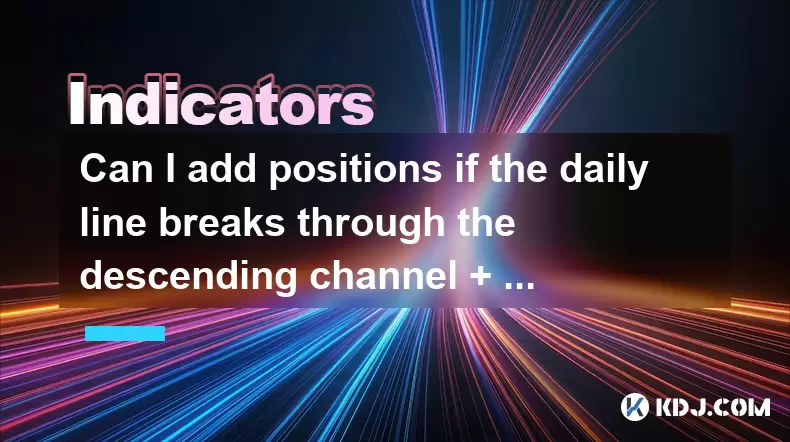
Can I add positions if the daily line breaks through the descending channel + the 30-minute moving average is in a bullish arrangement?
Jun 30,2025 at 11:00pm
Understanding the Descending Channel BreakoutWhen a daily line breaks through a descending channel, it indicates a potential shift in market sentiment from bearish to bullish. A descending channel is formed by drawing two parallel trendlines, where the upper trendline connects the lower highs and the lower trendline connects the lower lows. A breakout o...
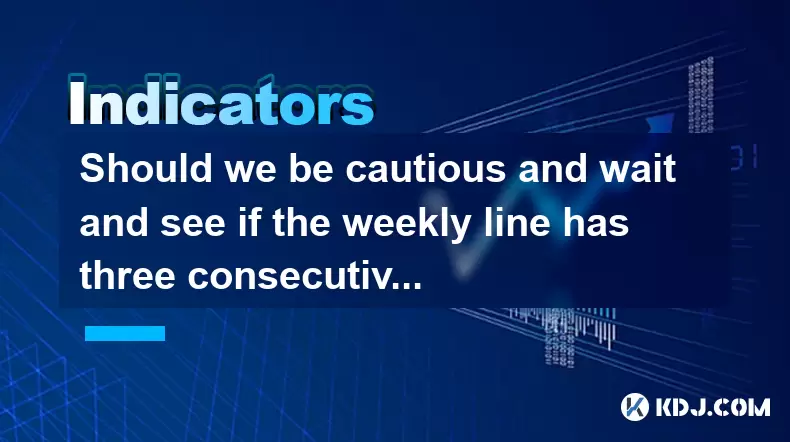
Should we be cautious and wait and see if the weekly line has three consecutive Yin lines + the daily MACD green column enlarges?
Jul 01,2025 at 12:42am
Understanding the Weekly Three Consecutive Yin Lines PatternIn technical analysis, three consecutive Yin lines on a weekly chart indicate a strong bearish trend. Each Yin line represents a week where the closing price is lower than the opening price, signaling consistent selling pressure. When this pattern appears three times in succession, it often sug...
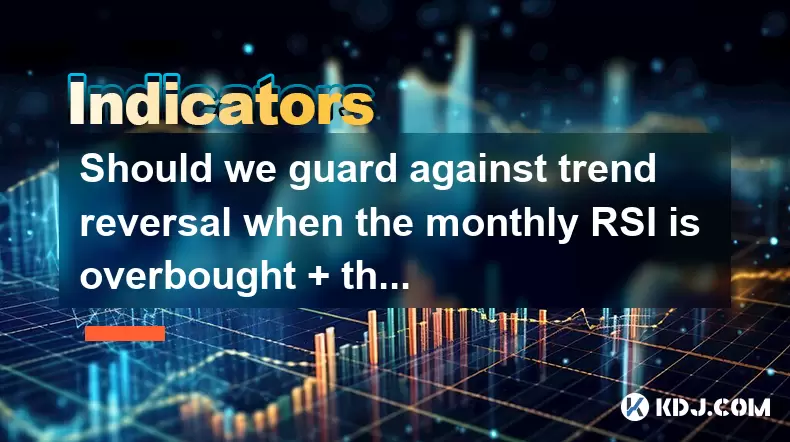
Should we guard against trend reversal when the monthly RSI is overbought + the weekly line has a long upper shadow?
Jun 30,2025 at 11:35pm
Understanding RSI Overbought Conditions in CryptocurrencyThe Relative Strength Index (RSI) is a momentum oscillator commonly used in technical analysis to identify overbought or oversold conditions in an asset. When the monthly RSI of a cryptocurrency reaches above 70, it is generally considered overbought, suggesting that the asset may be due for a pul...
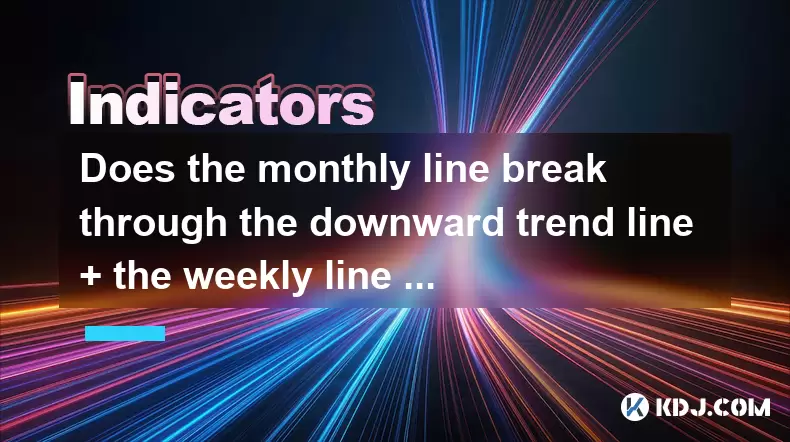
Does the monthly line break through the downward trend line + the weekly line with large volume confirm the reversal?
Jul 01,2025 at 04:49am
Understanding the Monthly Line Breakthrough in CryptocurrencyIn cryptocurrency trading, a monthly line refers to the price movement over a 30-day period represented on a candlestick chart. When this monthly line breaks through a downward trend line, it suggests that the long-term bearish momentum might be weakening. A downward trend line is drawn by con...
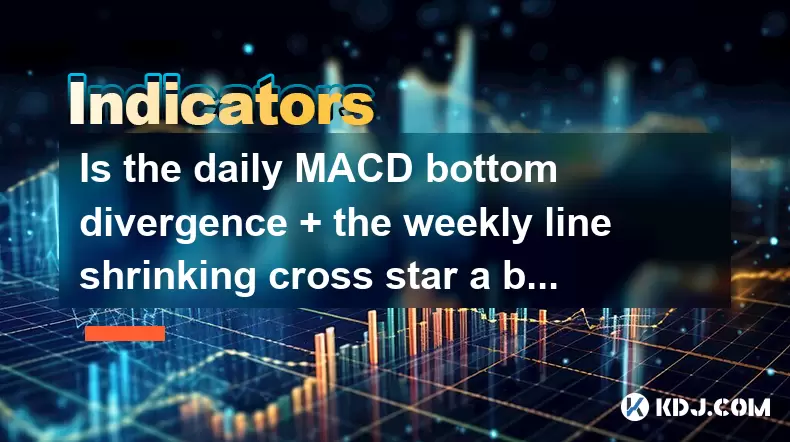
Is the daily MACD bottom divergence + the weekly line shrinking cross star a bottoming signal?
Jul 01,2025 at 03:49am
Understanding MACD Bottom Divergence in Cryptocurrency TradingThe Moving Average Convergence Divergence (MACD) is a widely used technical indicator among cryptocurrency traders to identify potential trend reversals. A bottom divergence occurs when the price of an asset makes a lower low, but the MACD line forms a higher low. This suggests that bearish m...
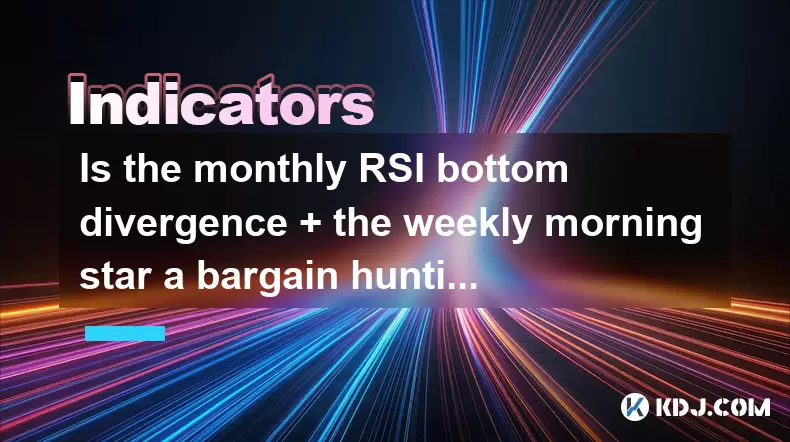
Is the monthly RSI bottom divergence + the weekly morning star a bargain hunting opportunity?
Jun 30,2025 at 09:57pm
Understanding RSI Bottom Divergence in Monthly TimeframesThe Relative Strength Index (RSI) is a momentum oscillator commonly used to identify overbought or oversold conditions in the market. When traders refer to a monthly RSI bottom divergence, they're observing a situation where the price makes a lower low, but the RSI makes a higher low on the monthl...

Can I add positions if the daily line breaks through the descending channel + the 30-minute moving average is in a bullish arrangement?
Jun 30,2025 at 11:00pm
Understanding the Descending Channel BreakoutWhen a daily line breaks through a descending channel, it indicates a potential shift in market sentiment from bearish to bullish. A descending channel is formed by drawing two parallel trendlines, where the upper trendline connects the lower highs and the lower trendline connects the lower lows. A breakout o...

Should we be cautious and wait and see if the weekly line has three consecutive Yin lines + the daily MACD green column enlarges?
Jul 01,2025 at 12:42am
Understanding the Weekly Three Consecutive Yin Lines PatternIn technical analysis, three consecutive Yin lines on a weekly chart indicate a strong bearish trend. Each Yin line represents a week where the closing price is lower than the opening price, signaling consistent selling pressure. When this pattern appears three times in succession, it often sug...

Should we guard against trend reversal when the monthly RSI is overbought + the weekly line has a long upper shadow?
Jun 30,2025 at 11:35pm
Understanding RSI Overbought Conditions in CryptocurrencyThe Relative Strength Index (RSI) is a momentum oscillator commonly used in technical analysis to identify overbought or oversold conditions in an asset. When the monthly RSI of a cryptocurrency reaches above 70, it is generally considered overbought, suggesting that the asset may be due for a pul...

Does the monthly line break through the downward trend line + the weekly line with large volume confirm the reversal?
Jul 01,2025 at 04:49am
Understanding the Monthly Line Breakthrough in CryptocurrencyIn cryptocurrency trading, a monthly line refers to the price movement over a 30-day period represented on a candlestick chart. When this monthly line breaks through a downward trend line, it suggests that the long-term bearish momentum might be weakening. A downward trend line is drawn by con...

Is the daily MACD bottom divergence + the weekly line shrinking cross star a bottoming signal?
Jul 01,2025 at 03:49am
Understanding MACD Bottom Divergence in Cryptocurrency TradingThe Moving Average Convergence Divergence (MACD) is a widely used technical indicator among cryptocurrency traders to identify potential trend reversals. A bottom divergence occurs when the price of an asset makes a lower low, but the MACD line forms a higher low. This suggests that bearish m...

Is the monthly RSI bottom divergence + the weekly morning star a bargain hunting opportunity?
Jun 30,2025 at 09:57pm
Understanding RSI Bottom Divergence in Monthly TimeframesThe Relative Strength Index (RSI) is a momentum oscillator commonly used to identify overbought or oversold conditions in the market. When traders refer to a monthly RSI bottom divergence, they're observing a situation where the price makes a lower low, but the RSI makes a higher low on the monthl...
See all articles

























































































